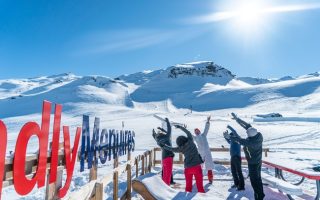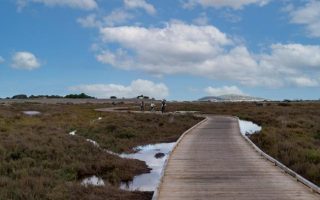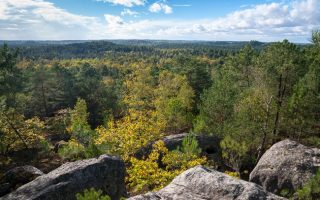Exploring Auvergne: Ballooning and Hiking in Volcano Country

Our pilot Dominique assures us that the lack of even a breeze is a very rare occurrence. It’s not even 7am and we’re at our third ‘test’ site, trying to get our hot air balloon off the ground, near the base of the Puy de Dôme, at the heart of the Auvergne. This beautiful volcanic area of the Central region has, amazingly, managed to remain relatively overlooked by overseas visitors. The early morning is calm and still but with absolutely no wind our hopes of taking off are sinking fast. However, it’s third time lucky, and within half an hour we’re soaring away in a brand new balloon that’s making its first-ever flight.
We drift over the Chaîne des Puys, a collection of around 80 dormant volcanoes which formed tens of thousands of years ago and eroded over time, leaving plugs of hardened magma that formed curved hilltops. Known as puys, these stretch some 35km from north to south, creating a sprawling, lunar-like landscape that’s dotted with interlocking and overlapping craters, lava domes and cinder cones. To the South, they’re flanked by the Massif du Sancy, one of several volcanic belts in the Auvergne, and the fertile plains of Limagne to the North. Unique in Europe, the Chaîne des Puys is a veritable volcanic museum, one which hopes for UNESCO World Heritage status, and at its centre, soaring to an altitude of 1,465m, sits the Puy de Dôme.
Singularly Magical
A spin in Ruby, as the Quatre Vents’ new hot air balloon is nicknamed, gives us unrivalled views and majestic vistas unfold as we ascend. The experience is almost otherworldly, with the morning mist blanketing the slopes and gathering in the valleys, the puys appear to be a sea of islands rising from amid the clouds. Perfect spring sunshine bathes the landscape in the most beautiful light while we aim to keep a connection between the sky and the ground by not climbing too high. We hear the birds chirping, and barking dogs and crowing roosters indicate that the villages below are slowly waking up.
With a maximum capacity of only three people in the balloon’s basket – a pilot and two passengers – our private flight provides a completely different experience to other hot air balloon tours we’ve embarked on in the past. Let’s face it, the atmosphere is hardly as romantic when you’re bundled in with a dozen or so others. But that’s also down to our pilot, Dominique Gouttequillet, an Auvergne native who’s full of knowledge about the region and is very enthusiastic to share it with us, pointing out all the various features of the local topography. With almost 40 years of flying experience under his belt – 20 years as a professional hang-glider and 19 and counting as a hot air balloon pilot – you could say that he was ‘born to fly’.
After nearly 90 minutes of cruising northwards, we gradually begin our descent, keeping our eyes peeled for wild deer as we skim the treetops of a small wood that’s a patchwork of pine, spruce, ash and birch trees. We glide towards the ground and make a smooth landing in a lush green meadow that’s awash with dandelion flowers, where a picnic basket bursting with croissants and pains aux chocolat awaits. Although a vol en Montgolfière (balloon flight) isn’t the most physical of activities, we’d certainly worked up an appetite!
Hikers’ Playground
Something a little more strenuous, and another reason that intrepid visitors seek out the Auvergne, is hiking and this gives us a chance to see the region’s dramatic volcanic scenery up close. We meet our guide, Christophe Anglade from Aluna Voyages, at the foot of the Puy de Dôme, where we hop aboard the electric train of the Panoramique des Dômes, a three-year-old, 5.2km-long ‘rack’ railway which takes us to the summit in just 20 minutes.
The dormant volcano’s popularity as a hiking destination goes back as far as the 1870s, when it boasted an inn, which was followed by the building of a hotel. By the early 20th century, the number of visitors had grown so much that a railway was built to connect the Puy de Dôme with nearby Clermont-Ferrand, one of France’s oldest cities.
Reaching the peak, we take in the stunning, 360-degree panorama, which reveals the landscape to be a tapestry of colours which rises to and falls from the horizon. To the south lies the Puy de Sancy – at a towering 1,885m it’s the highest mountain in the Massif Central – while the black lava stone spires of the Cathédrale Notre-Dame-de-l’Assomption de Clermont-Ferrand can be spotted to the East. Above us, colourful wings dot the azure sky as the Puy de Dôme is a well-known paragliding spot. After a leisurely lunch at Le 1911, the gastronomic restaurant atop the volcano – named for the year that Eugène Renaux and Albert Senouque flew a Farman airplane from Paris to the summit in just five hours and 10 minutes – we don our boots for a 12km trek.
Le Chemin des Chèvres (The Way of the Goats) is an easy walk down the face of the Puy de Dôme and leads us to the Nid de la Poule (Hen’s Hest). It’s a ‘maar’, formed when molten lava came into contact with water while on its way to the earth’s surface, which caused an explosion that created a circular pit resembling a crater.
A Floral Feast
In addition to being a fount of information when it comes to volcanology, Christophe is also something of a walking encyclopedia on the subject of wild plants. Lamenting that they’re a forgotten source of food, he delights in sharing his favourite recipes, pointing out dozens of species and explaining their uses. We learn that, in a bid to stay young, women have used the sap from the flower of ‘Lady’s Mantle’ for bathing since the Middle Ages. Meanwhile, the sap of the ‘Common Daisy’ – whose Latin name, Bellis Perennis, means ‘everlasting beauty’ as it flowers year-round – was mixed with other substances to give tighter, firmer skin. Like many other plants we encounter, the daisy’s young leaves, flower buds and petals can be eaten raw in salads.
We also come across some ‘European Bistort’, whose leaves, we’re told, are used in a bitter herb pudding made in northern England during Lent. Christophe encourages us to sample many plants, including the not very appetisingly named ‘Hogweed’. With strong flavours of coconut and citrus fruit, it is also known as ‘Bear’s Paw’ due to its hairy stem. Hogweed was also said to be the plant of the Greek demigod Hercules – its scientific name is Heracleum – and back in Antiquity it was believed that eating it would build strength.
We’re struck at how quiet and empty the hiking trail is, despite the pleasant early spring weather and our adventure coinciding with the French school holidays. We feel like we’ve stumbled upon something secret as we wind between towering beech trees covered in silky moss, crossing paths with very few fellow hikers. After walking northwards for about an hour or so, we reach the base of Puy Pariou, where a steep staircase and 15-minute climb to the top await. We’re again granted stunning, 360-degree views of the volcanoes and it’s a picturesque resting place to catch our breath before we set off on the return journey, via a narrow trail tucked away in dense thicket.
After the hike, we retire to Volca’Lodges, our home for the night. Nestled in a peaceful hamlet overlooking a forested valley, this collection of ten low-energy eco-lodges was built using locally-sourced wood, and according to our friendly hosts, Cécile and Lionel Tixier, all of the construction material came from within 150km of the site.
At the heart of Volca’Lodges is a former stable-turned-restaurant, La Table de Marceline, which boasts beautiful, original exposed stone walls, soaring vaulted ceilings and a menu of delicious, hearty dishes – such as lamb shoulder shepherd’s pie with lemon and rosemary – which use only locally-sourced ingredients. Our cosy and comfortable lodge for two is incredibly private and secluded, but the icing on the cake is the hot and bubbling jacuzzi which takes pride of place on the spacious deck. A soak under the stars or as the sun sets, with an apéritif in hand, is the perfect way to cap off our day spent exploring just a small of part this uniquely fascinating area of France.
Auvergne Essentials: Want to experience this volcanic wonderland? Here’s what you need to know…
Hot Air Ballooning
Quatre Vents: These private hot air balloon tours give you a bird’s eye view of the Auvergne’s volcanic landscape. Contact: Dominique Gouttequillet. Tel: +33 4 73 62 29 30. [email protected]
Hiking & Walking
Aluna Voyages: Guided/self-guided hikes and nature walks. Contact: Christophe Anglade. Tel: +33 4 73 65 92 55. [email protected]
Accommodation
Volca’Lodges: Eco-getaway in the heart of Auvergne. Contact: Cécile and Lionel Tixier. Tel: +33 4 73 84 96 69. [email protected]
From France Today magazine
Share to: Facebook Twitter LinkedIn Email
More in auvergne, hot air balloon
Leave a reply
Your email address will not be published. Required fields are marked *



